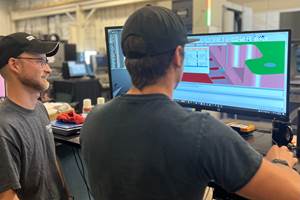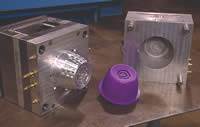Wiping the Slate Clean with a Brand-New Facility
“After the two-week transition period, we were operating smoother than we were at our previous facility.”
In its 22-year history, Plasticraft Molds, Inc. (Richfield, WI) was sold to another moldmaker in 2003 and subsequently shut down before President Eric Marlow reopened it in 2006. So, when an overcrowded building made workflow difficult, Marlow jumped at the chance to break ground on a new facility, wipe the slate clean and have a “facility to form to our business, not our business to form to a facility.”
Plasticraft builds plastic injection molds for the automotive, medical, industrial automation and consumer products markets. According to Marlow, the company was operating at more than full capacity at its previous location. “We knew we had to move into a larger facility, and didn’t feel it was advantageous for us to lease a larger facility,” he recalls. “We also looked at purchasing existing facilities. Existing facilities have good value in this economy, but we weren’t able to find anything that fit our business.”
Therefore, the company built a facility from the ground up—and left room for expansion, which Marlow anticipates happening within the next five years. Marlow worked with a local commercial builder who had experience with custom facilities. He notes the process took approximately 14 months—six months of design time and eight months of build time. The new building stands at 11,000 square feet, more than double the size the previous facility occupied at 5,000 square feet.
Marlow has taken full advantage of the extra space, adding a Milltronics VM25XP 50 taper machine for roughing core and cavity components and machining mold bases. “We saw the need in that department as we were forced to outsource this machining last year,” he notes, “and we had to wait to purchase it until the move.” The new facility boasts a conference room, three private offices, six semi-private work stations, and a fully equipped lunch room/kitchen with an outdoor patio. The company also added an Engel 150-ton press to increase its sampling capacity for larger tools (it already has an 80-ton press).
The move was both physically and mentally demanding on the entire Plasticraft team, Marlow notes. “After the two-week transition period, we were operating smoother than we were at our previous facility,” he states. “We had some internal changes that included a change in management (now we have a core group that manages the work flow), more employee responsibilities and better scheduling abilities, which make us far more organized. Everyone stepped up to the plate and organized their department so the work flows smoothly to the next department.”
Marlow would like that success to continue, and is anticipating another expansion within five years. “We put our best work into our tools, and that shows all the way through into the style and layout of our new upscale facility,” he concludes. “We have had steady growth since re-starting in 2006. Our sales have grown 25 to 30 percent annually since then; and we doubled our sales in 2012. We have to keep a close eye on costs making sure we can get the most out of everything—while maintaining high quality mold building.”
For More Information
Plasticraft Molds, Inc. / (262) 251-6800
ericm@plasticraftmolds.com / www.plasticraftmolds.com
Related Content
The In's and Out's of Ballbar Calibration
This machine tool diagnostic device allows the detection of errors noticeable only while machine tools are in motion.
Read MoreFive-Axis Graphite Mill With Automation Debottlenecks Electrode Machining
Five-axis electrode cutting enabled Preferred Tool to EDM complex internal screw geometry on an insert that otherwise would have had to be outsourced.
Read MoreIntegrated CAD/CAM Streamlines Electrode Manufacture, Improves Quality
A focus on electrode design and automation helps toolroom improve efficiency, reduce tooling costs and deliver higher quality products.
Read MoreCAD/CAM Software Reduces Delivery Times by 70% With a Six-Month ROI
Single integrated CAD/CAM package reduces translation errors, simplifies design process, improves shop efficiency and shortens tool lead times.
Read MoreRead Next
New Software Makes Faster, Better, Cheaper a Reality
With a new CAM package a moldmaker/molder can now receive a job in digital format and actually cut metal before it even outputs drawings.
Read MoreReasons to Use Fiber Lasers for Mold Cleaning
Fiber lasers offer a simplicity, speed, control and portability, minimizing mold cleaning risks.
Read MoreHow to Use Continuing Education to Remain Competitive in Moldmaking
Continued training helps moldmakers make tooling decisions and properly use the latest cutting tool to efficiently machine high-quality molds.
Read More





















